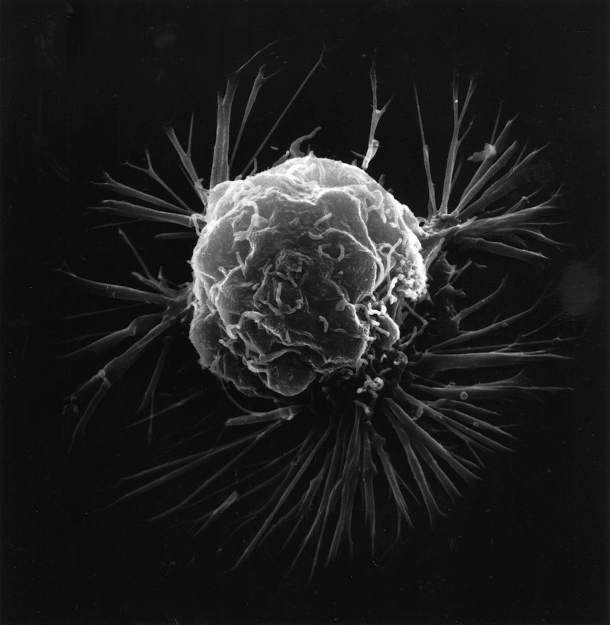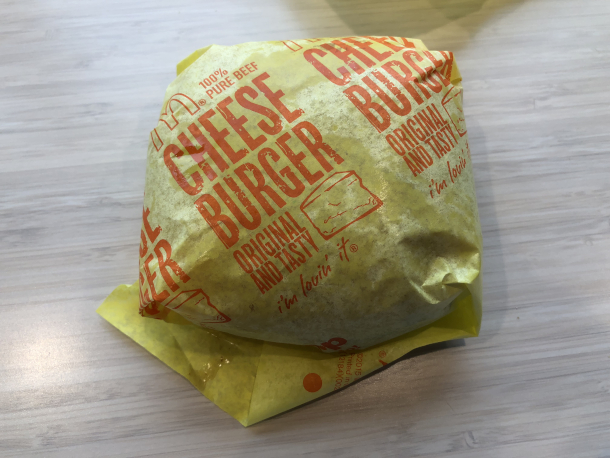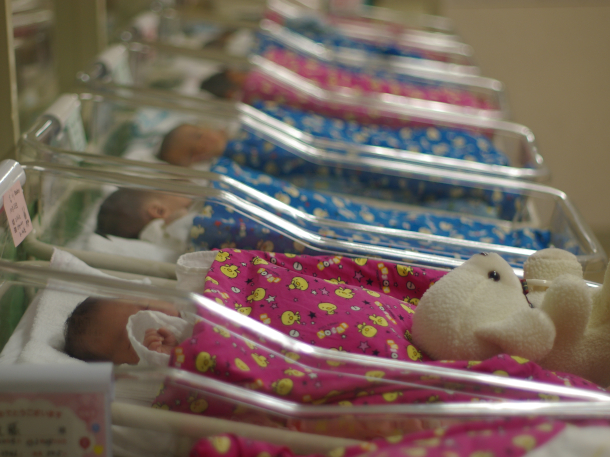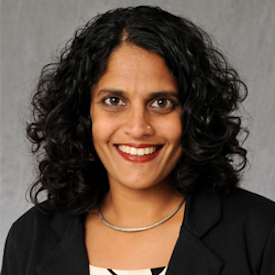A New War on Cancer – Part 1
Air Date: Week of July 7, 2023

A breast cancer cell, photographed by a scanning electron microscope. Photo: National Cancer Institute, Wikimedia Commons)
Treatments for cancer are better than ever, but cases continue to rise and cancer is still the second leading cause of death in the US. And with environmental factors linked to as many as two thirds of all cancer cases, some are calling for stronger chemical regulations as a means of cancer prevention. Kristina Marusic is the author of the book “A New War on Cancer: The Unlikely Heroes Revolutionizing Prevention” and joins Host Steve Curwood in Part 1 of their conversation to talk about why prevention is often overlooked.
Transcript
DOERING: President Richard Nixon declared a war on cancer when he signed the National Cancer Act in 1971 and unleashed a wave of oncology training programs across the country. Now, more than 50 years later, treatments are better than ever, but cancer is still the second leading cause of death in the U.S., claiming the lives of one in five men and one in six women. And according to a 2008 study by a team at MD Anderson Cancer Center in Texas, more than two thirds of all cancer cases are linked to preventable environmental causes, including chemical exposure.
CURWOOD: Yes, and since the 1970s, more than 87,000 chemicals have been approved for commercial use in the U.S., but only around a thousand have been studied for their potential to cause cancer. And unlike the European Union, which takes a precautionary approach when it comes to approving chemicals, the United States generally does not examine the safety of chemicals before they’re put on the market for consumer use. But there are scientists and leaders across the U.S. advocating for stronger chemical regulation as a means of cancer prevention, as Kristina Marusic points out in her book, A New War On Cancer: The Unlikely Heroes Revolutionizing Prevention. Kristina is a journalist for Environmental Health News and joins us now from Pittsburgh, Pennsylvania. Kristina, welcome back to Living on Earth!
MARUSIC: Hi, thanks so much for having me.
.jpg)
A New War on Cancer is Kristina Marusic’s first book. (Image: courtesy of Island Press)
CURWOOD: So, when President Biden came into office, he announced a war on cancer. How does that compare to the new war on cancer you're talking about here?
MARUSIC: Biden's war on cancer is a big influx of funding for, mainly, cancer treatment and looking for cure for cancer, which is important and worth pursuing, but my book really focuses on cancer prevention. And the new federal Cancer Moonshot plan does talk about prevention in a more meaningful way than it has in the last 50 years, so that's an exciting new development, but I'm still hoping to see more of a focus on prevention than we have in the past.
CURWOOD: I get the impression from reading your book that we spent an awful lot more on treating and trying to cure cancer than dealing with prevention. I'm wondering, to what extent is that related to where the money is, that this big money to help cure older people, perhaps who have a lot of money, and there's not a lot of money to help prevent cancer in kids and other people who have so much risk.
MARUSIC: So right now, it's estimated that only 7-9% of global cancer funding goes toward prevention and the rest goes toward treatment and cures, and one of the big reasons for that is money. So, the global oncology market was valued at around $280 billion in 2021, and it's expected to reach more than $580 billion by 2030. Cancer cases are expected to rise by 47% from 2020 to 2040, and investors point to that as evidence of strong growth for that market and, unfortunately, no one stands to profit like that from cancer prevention. So, if we want to shift our focus to cancer prevention, that's going to have to come from places outside of the market, through things like regulations and laws.

McDonald’s, one of the fast-food companies found to use PFAS in their packaging, vowed to stop using PFAS chemicals entirely by 2025. PFAS chemicals have been linked to kidney and testicular cancers, with links to other cancers under investigation. (Photo: Famartin, Wikimedia Commons)
CURWOOD: I'm wrinkling my brow because that kind of thinking sounds like, say, people who make ambulances seeing the car crash rate go up as a sign for better business for them. If people crash cars more, then they'll be able to sell more ambulances that'll get used without thinking about the tragedy behind the crashes.
MARUSIC: Yeah, it's a little distasteful, isn't it, to think about people profiting off of cancer treatments, but unfortunately, that's where the money is. And if we think about this, you know, if this was an actual war, this would be like spending 91% of our budget on treating soldiers who came back from the battlefield wounded, and only 9% of our funding on offensive or defensive measures that could stop them from getting hurt in the first place. So, it's not a great strategy, which is why my book is advocating for a bigger focus on prevention, specifically, preventing our exposure to cancer-causing chemicals in our everyday lives.

According to the American Cancer Society, about 9,910 children in the United States under the age of 15 will be diagnosed with cancer in 2023. (Photo: Tamaki Sono)
CURWOOD: One of the surprising pieces of information in your book is about the rising rates of childhood cancer. Since the 1970s, you say they've increased substantially, and it's now the leading cause of death by disease for children in this country. Why is that? Why are children so vulnerable to cancer now?
MARUSIC: Kids are vulnerable to all sorts of environmental exposures, more so than adults, because their systems that can help filter toxic chemicals out of their bodies are still developing, right? They're not fully there yet to be able to kind of process through harmful things that enter their bodies in the same way than an adult body can. They're also undergoing really complex development that adults have already been through and for all of that development to happen correctly, a long sequence of events needs to happen in just the right order, and at just the right time. And so, when there's a disruption to those processes, kids are more sensitive to those disruptions than adults are. There's also this growing body of research that suggests that parents’ exposures, both before and during pregnancy, can play a big part in not only childhood cancer risk, but also the risk that their kids will develop cancer as an adult, and there are a handful of more recent studies suggesting that those types of exposures might influence cancer risk for up to two or three generations. So, like, your grandmother's exposure to a cancer-causing chemical in the environment might influence your cancer risk, either in childhood or in adulthood.
CURWOOD: That's not good news, I have to say.
MARUSIC: It's not good news, no. It's a little alarming.

This ethane cracker plant owned by Shell is located outside of Pittsburgh, Pennsylvania. It uses ethane gas to make polyethylene, a process that releases cancer causing chemicals like benzene, toluene, hexane, formaldehyde and ammonia. After a lawsuit filed by environmental groups, Shell agreed to pay $10 million to Pennsylvania for violating state air quality regulations. (Photo: Nathan Smallwood)
CURWOOD: Kristina, why do you think it was important to include the stories of the scientists and doctors that are working on cancer prevention as you tell your story?
MARUSIC: So I mentioned that that funding problem we have with cancer prevention, that's one of the reasons we tend to not have resources devoted to prevention. The other reason for that is that it's a lot easier to advocate for cures and treatments than it is to advocate for prevention. So, when you're advocating for a cure or a treatment for cancer, you can put the face of a mom or a cute little kid on the poster or on the t-shirts, or on the Facebook page, someone who's battling cancer and it's really easy to get people to feel empathy and want to join the fight and help them out, because how could you not? And when we talk about prevention, it ends up being really data-heavy. So, there's a lot of statistics, and there's a lot of long-term trends in cancer rates, and it's just the nature of prevention that you don't get to know whose cancer you prevented. So, you don't get to meet the person whose life you saved, or get hugs from the family you spared from going through a cancer diagnosis and going through the process of getting treatment, and that's why I wanted to include these stories in my book. So, I profiled people who are advocating for cancer prevention, because I really wanted to humanize this story and try to put a face to cancer prevention. And I also found that as I was reporting on this topic as a journalist, the more I learned about these people who've devoted their lives to this work, the more I felt hopeful about our ability to do something to change this. And the more it made me feel inspired to want to get involved and help out, and so I hope it does that for readers, too.

Ami Zota is an environmental health scientist at Columbia University and directs the Agents of Change in Environmental Justice program. (Photo: Courtesy of Ami Zota)
CURWOOD: Now, throughout your book, you point to a few scientists or some leaders who are working hard to bring awareness to cancer-causing chemicals, and push for legislation or other steps to phase them out. Could you please walk us through the Ami Zota story?
MARUSIC: Sure. Ami Zota is a public health researcher and professor at Columbia University's School of Public Health. And her story is really interesting. So her background, long before she became a professor, she's a second-generation Indian American who grew up in rural North Carolina, and she told me that as a kid, she never imagined that she would be a scientist or a professor, in part because she'd never seen any women who looked like her in those kind of roles. Ami's life has been wildly different from the lives of previous generations of women in her family. Her mom grew up milking cows and water buffaloes in a rural part of India. And Ami's mom stopped going to school after fourth grade so she could stay home and help raise her seven siblings. And then, at a young age, she entered into an arranged marriage with Ami's dad, and Ami’s dad worked the night shift at their village gas station, but he wanted more than the opportunities their hometown could offer and he'd always been really good at school. So, he applied for scholarships, and he got one to go to medical school in a nearby city. And eventually, Ami's dad moved to the United States to finish up his medical residency at a hospital in Chicago, and he sent for Ami’s mom a year later. When she first moved to the States, Ami's mom didn't speak a word of English. She told me it was really difficult, tough for her mom to adjust, she was still really close with her family, and she was really homesick. And soon after, the family moved to rural North Carolina, where Ami grew up, and she shared with me how hard it was being the only Indian American that most of her classmates and her teachers had ever encountered. She shared one story about a friend coming over to play once when she was very young, and her grandparents were visiting from India. And the friend got so scared of Ami's grandparents that she started crying. She shared that one of her teachers consistently mispronounced her name as “Army.” And all of these experiences really helped shape the work that Ami does now as a researcher and as a professor.
Links
Learn more about Kristina Marusic
National Library of Medicine “Environmental exposures and cancer: using the precautionary principle”
National Cancer Institute “Cancer-Causing Substances in the Environment”
Living on Earth wants to hear from you!
Living on Earth
62 Calef Highway, Suite 212
Lee, NH 03861
Telephone: 617-287-4121
E-mail: comments@loe.org
Newsletter [Click here]
Donate to Living on Earth!
Living on Earth is an independent media program and relies entirely on contributions from listeners and institutions supporting public service. Please donate now to preserve an independent environmental voice.
NewsletterLiving on Earth offers a weekly delivery of the show's rundown to your mailbox. Sign up for our newsletter today!
 Sailors For The Sea: Be the change you want to sea.
Sailors For The Sea: Be the change you want to sea.
 The Grantham Foundation for the Protection of the Environment: Committed to protecting and improving the health of the global environment.
The Grantham Foundation for the Protection of the Environment: Committed to protecting and improving the health of the global environment.
 Contribute to Living on Earth and receive, as our gift to you, an archival print of one of Mark Seth Lender's extraordinary wildlife photographs. Follow the link to see Mark's current collection of photographs.
Contribute to Living on Earth and receive, as our gift to you, an archival print of one of Mark Seth Lender's extraordinary wildlife photographs. Follow the link to see Mark's current collection of photographs.
 Buy a signed copy of Mark Seth Lender's book Smeagull the Seagull & support Living on Earth
Buy a signed copy of Mark Seth Lender's book Smeagull the Seagull & support Living on Earth

